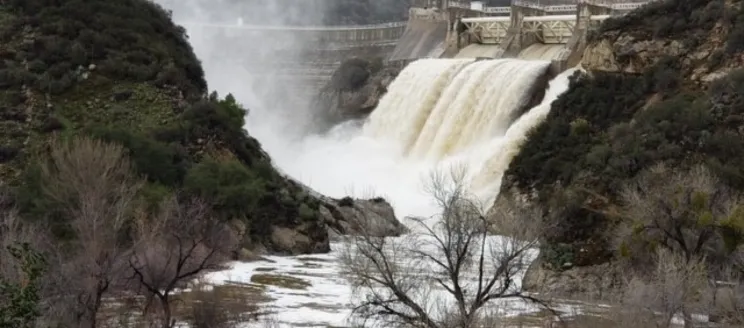
Recent Rains Bring Improvements to the City’s Water Supply and Locally Produced Carbon-Free Electricity Production
Thanks to recent rain, Gibraltar Reservoir, a key City water source upstream of Cachuma Reservoir, filled to capacity and began spilling water over the spillway on January 5; the first time in three years. In addition to playing an important part in the City’s diverse water supply portfolio, Gibraltar when full also enables the City to operate it’s Hydroelectric Plant, which produces 100% carbon-free renewable energy. When the Hydroelectric Plant is running at full capacity, it can produce enough electricity to completely offset 100% of the Cater Water Treatment Plant’s total electrical usage with clean, carbon-free electricity.
Water captured in Gibraltar Reservoir (along with flows from Devil’s Canyon Creek) are conveyed through the Santa Ynez Mountains via the 3.7 mile long Mission Tunnel. Once the water reaches the south portal of Mission Tunnel (near Tunnel Trailhead), it enters into the Gibraltar penstock pipeline, dropping over 600 feet in elevation as it makes its way to the Gibraltar Hydroelectric Plant located at Lauro Reservoir (near Jesusita Trailhead). On January 19th, City staff put the Gibraltar Hydroelectric Plant back into service. The journey from Gibraltar to Lauro Reservoir takes the water about four to five hours.
The City’s water supply outlook has improved significantly due to recent rain events. With Gibraltar Reservoir and Lake Cachuma full, we have sufficient water for at least the next three years, even if we find ourselves entering another prolonged drought. The key to meeting the water needs of Santa Barbara has been, and continues to be, a diverse water supply portfolio. The City has developed one of the most diverse water supply mixes in the State, given our vulnerability to droughts, wildfires, mudslides and earthquakes. Our water supplies include: Gibraltar, Devils Canyon Creek, Mission Tunnel, Cachuma, seawater desalination, groundwater, State Water Project water, recycled water for landscaping, and water conservation. Each of the City’s supplies has its role to play, and each year the City analyzes and plans for the right mix of water supplies to most cost effectively meet City demands, while also planning for the next drought or disaster.
The City will continue to plan for dry weather in the future; the past several years have taught us that another dry period might be just around the corner. It is expected that climate change will result in prolonged dry periods and more intense wet periods, necessitating flexible and responsive management of the City's water resources moving forward in an uncertain future. You can learn more about our long-term water supply plan in the City’s Enhanced Urban Water Management Plan.
The City thanks the community for embracing water efficiency as a way of life, and being leaders in wise water use. Santa Barbara residents are currently using the same amount of water used in the 1950s, but with nearly double the population, highlighting the impact of water efficiency and increasingly more efficient building codes. The community’s water use currently averages 25 percent less than pre-drought water use in 2013. We can all continue to make a difference and stretch our water supplies by being as efficient as possible with our water use.
For more information on storm effects on the City’s water supply, tune into the City Council Meeting on Tuesday, February 7.
For information on the City of Santa Barbara’s water sources, please visit www.SantaBarbaraCA.gov/WaterSources
View an image of Gibraltar Reservoir filled to capacity on January 5, 2023, boosting the City’s water supplies and hydropower HERE.
View a video clip of Gibraltar Dam after the rainfall captured by Santa Barbara County Sheriff’s Office HERE.
